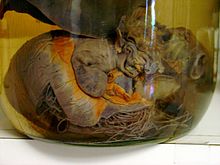| Dirofilaria immitis | |
|---|---|

| |
| A German Shepherd dog heart infested with Dirofilaria immitis | |
| Scientific classification | |
| Domain: | Eukaryota |
| Kingdom: | Animalia |
| Phylum: | Nematoda |
| Class: | Chromadorea |
| Order: | Rhabditida |
| Family: | Onchocercidae |
| Genus: | Dirofilaria |
| Species: | D. immitis
|
| Binomial name | |
| Dirofilaria immitis (Leidy, 1856)
| |
| Synonyms[1] | |
|
Filaria immitis Leidy, 1856 | |
Dirofilaria immitis, also known as heartworm or dog heartworm, is a parasitic roundworm that is a type of filarial worm, a small thread-like worm, and which causes dirofilariasis. It is spread from host to host through the bites of mosquitoes. Four genera of mosquitoes transmit dirofilariasis, Aedes, Culex, Anopheles, and Mansonia.[2] The definitive host is the dog, but it can also infect cats, wolves, coyotes, jackals, foxes, ferrets, bears, seals, sea lions and, under rare circumstances, humans.[3]
Adult heartworms often reside in the pulmonary arterial system (lung arteries) as well as the heart, and a major health effect in the infected animal host is a manifestation of damage to its lung vessels and tissues.[4] In cases involving advanced worm infestation, adult heartworms may migrate to the right heart and the pulmonary artery. Heartworm infection may result in serious complications for the infected host if left untreated, eventually leading to death, most often as a result of secondary congestive heart failure.
- ^ "Dirofilaria immitis (Leidy, 1856)". Global Biodiversity Information Facility. Retrieved 21 August 2023.
- ^ Prevention, CDC-Centers for Disease Control and (2019-04-16). "CDC – Dirofliariasis – Biology – Life Cycle of D. immitis". www.cdc.gov. Retrieved 2020-05-07.
- ^ "American Heartworm Society | FAQs". Heartwormsociety.org. Retrieved 2014-07-04.
- ^ Ettinger, Stephen J.; Feldman, Edward C. (2010). Textbook of Veterinary Internal Medicine (7th ed.). W.B. Saunders Company. ISBN 978-1-4160-6593-7.